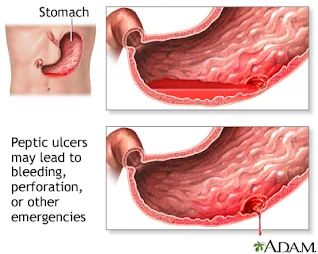What Causes Peptic Ulcer? Peptic Ulcer Disease Treatment
In uncomplicated peptic ulcer disease, the clinical findings are few and nonspecific. “Alarm features" that warrant prompt gastroenterology referral include bleeding, anemia, early satiety, unexplained weight loss, progressive dysphagia or odynophagia, recurrent vomiting, and a family history of gastrointestinal (GI) cancer.
RELATED: Gastritis/Stomach Ulcer: The Best Natural Remedy For Ulcer
After reading this article, you will get to know and understand the following:
- What is peptic ulcer?
- Causes of peptic ulcer
- Preventions
What is a peptic ulcer?
A peptic ulcer is a break in the inner lining of the esophagus, stomach, or duodenum.
Causes of Peptic Ulcer
- Excess gastric acid is still considered necessary for the formation of ulcers.
- Helicobacter pylori (H. pylori)
- NSAIDs (nonsteroidal anti-inflammatory drugs), including aspirin,ibuprofen (Motrin), naproxen(Naprosyn)
- NSAIDs cause ulcers by interfering with prostaglandins in the stomach.
- These ulcers can be caused by wrong food or too much food.
- Drinking too much alcohol
- Coffee, colas, spicy foods, and caffeine
- Smoking cigarettes
Peptic Ulcers:
Gastric & Dudodenal
Symptoms of Peptic Ulcer
- Abdominal pain after around three hours of taking a meal.
- Upper abdominal pain that wakes you up at night around 1-2
- Pain just beneath the breastbone is a frequent symptom of an ulcer. Sometimes it radiates to the back.
- Feeling of fullness – unable to drink as much fluid, bloating and abdominal fullness;
- Mild nausea (vomiting may relieve this symptom)
- Loss of appetite and weight loss;
- Vomiting of blood
- Bloody or dark tarry stools
- Chest pain and back pains
- Fatigue
- Weight loss (6 Common Health Issues that Cause Unexplained Weight Loss)
Lab tests to confirm Peptic Ulcer
- Testing for H. pylori is also needed.
- Hemoglobin blood test to check for anemia
- Stool occult blood test
- Eat more fruits and vegetables especially, Pawpaw, Carrots and cabbage. Drink more water.
- Do not eat fried foods, tea, caffeine products, salt, chocolate, animal fats.
- A diet high in sugar increases HCl production. White bread also causes more HCl to be made.
- Avoid all diary milk, that the calcium in milk only stimulates acid production rather than decreasing it, as was taught for years.
- Well-cooked brown rice and millet are good.
- Do not eat between meals.
- Doing so slows emptying of the stomach, and thereby increases HCl amounts in the stomach.
- Do not use medicinal drugs.












.jpeg)